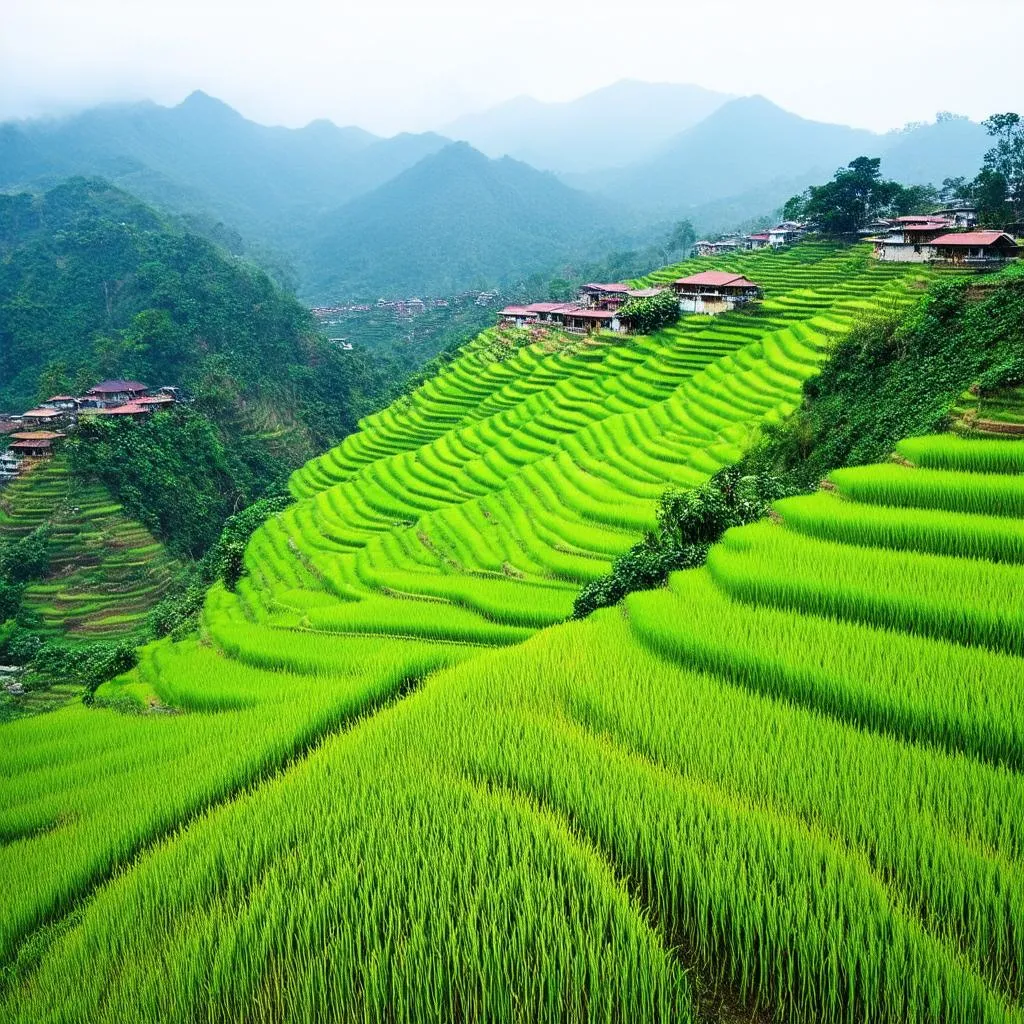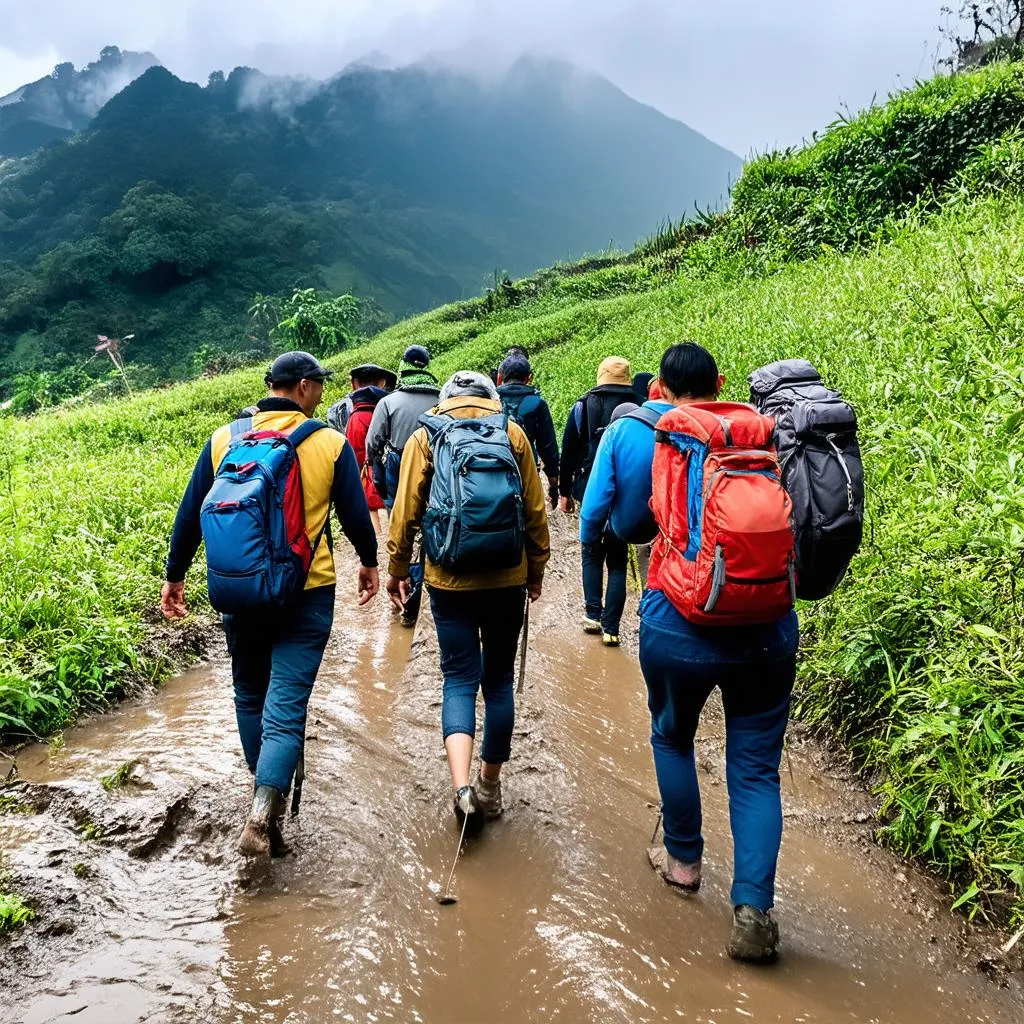“Not all those who wander are lost,” J.R.R. Tolkien once wrote. This rings especially true for those who choose to embark on a self-guided adventure through the misty mountains of Sapa, Vietnam. Ditch the tour bus and pre-planned itineraries; this guide is your key to unlocking the magic of Sapa on your own terms.
Unveiling Sapa: More Than Just a Mountain Town
Nestled amidst the Hoang Lien Son mountain range in northwest Vietnam, Sapa is famous for its dramatic rice terraces, cascading waterfalls, and vibrant indigenous culture. But beyond these iconic sights lies a world of hidden gems waiting to be discovered. Imagine yourself hiking through bamboo forests, sipping Vietnamese coffee with breathtaking valley views, or bartering for handicrafts in a local market – these are the experiences that truly capture the spirit of Sapa.
 Terraced rice fields in Sapa
Terraced rice fields in Sapa
Why Choose DIY Travel in Sapa?
Traveling independently allows you to set your own pace, delve deeper into local experiences, and create a journey uniquely your own. Want to spend an extra day exploring the Cat Cat Village? Go for it! Feel like skipping a planned hike and opting for a relaxing massage instead? Absolutely! Sapa rewards those who embrace spontaneity and forge their own path.
Planning Your Sapa Adventure: A Step-by-Step Guide
1. Visa and Flights:
Ensure you have a valid visa for Vietnam. Several international airlines fly into Noi Bai International Airport (HAN) in Hanoi. From there, you can reach Sapa by overnight train (approximately 8 hours) or bus (approximately 6-7 hours).
2. Best Time to Visit:
Sapa’s weather is notoriously unpredictable. The best time to visit is during the shoulder seasons (March-May and September-November) when the weather is mild and the rice terraces are lush and green.
3. Accommodation Options:
From budget-friendly homestays to luxurious resorts, Sapa offers a diverse range of accommodation to suit all budgets. Booking in advance, especially during peak season, is highly recommended. Consider staying at a homestay in a village like Ta Van or Lao Chai for a truly immersive cultural experience.
4. Transportation in Sapa:
Renting a motorbike is a popular way to explore the surrounding countryside at your own pace. However, if you’re not a confident rider, taxis and xe oms (motorbike taxis) are readily available.
5. What to Pack:
Pack for all weather conditions, including layers of clothing, a raincoat, and sturdy hiking shoes. Don’t forget insect repellent, sunscreen, and a hat.
 Tourists trekking in Sapa
Tourists trekking in Sapa
Immersing Yourself in Sapa’s Cultural Tapestry: Must-Do Experiences
1. Trek Through Breathtaking Landscapes:
Lace up your hiking boots and embark on a trek through Sapa’s iconic rice terraces. Popular trekking routes include those to Cat Cat Village, Ta Phin Village (known for its Red Dao ethnic minority and traditional herbal baths), and Lao Chai – Ta Van Village. Hiring a local guide is highly recommended, not only for their knowledge of the trails but also for their insights into the local culture.
2. Experience Local Life in Ethnic Villages:
Sapa is home to several ethnic minority groups, each with their unique traditions and customs. Visiting villages like Cat Cat (Hmong people), Ta Phin (Red Dao people), and Lao Chai – Ta Van (Giay and Black Hmong people) offers a fascinating glimpse into their way of life. Engage with the locals, learn about their handicrafts, and savor a traditional meal.
3. Conquer Fansipan Peak (Optional):
For the adventurous souls, climbing Fansipan (3,143 meters), the highest peak in Indochina, is an exhilarating challenge. The climb can be demanding, but the panoramic views from the summit are truly rewarding. Alternatively, you can take the cable car for an easier ascent.
4. Indulge in Sapa’s Culinary Delights:
From steaming bowls of pho to savory thit lon cap nach (grilled mountain pig), Sapa’s cuisine is a treat for the senses. Don’t miss trying local specialties like thắng cố (horse meat stew), com nuong (grilled rice), and rau cai meo (stir-fried mountain vegetables).
Sapa Travel Tips: Unveiled
– Money Matters: Vietnamese Dong (VND) is the local currency. ATMs are readily available in Sapa Town.
– Bargaining Power: Haggling is commonplace in local markets. Don’t be afraid to negotiate prices for souvenirs.
– Respectful Interactions: When visiting ethnic villages, dress modestly and ask permission before taking photos of people.
– Responsible Tourism: Support local businesses, minimize plastic waste, and be mindful of your impact on the environment and the local community.
FAQs About DIY Travel in Sapa: Your Queries Answered
1. Is it safe to travel solo in Sapa?
Yes, Sapa is generally safe for solo travelers. However, it’s always wise to take precautions, especially when trekking alone.
2. How much does a DIY trip to Sapa cost?
The cost depends on your travel style, but you can expect to spend around $30-$50 per day for budget-conscious travelers.
3. Do I need to book accommodation in advance?
Booking in advance, especially during peak season (September-November), is highly recommended to secure your preferred accommodation.
4. Can I drink the tap water in Sapa?
It’s best to stick to bottled water.
Embark on Your Sapa Adventure Today
Sapa is more than just a destination; it’s an experience. It’s a place where adventure meets tranquility, where ancient traditions intertwine with modern life. So, pack your bags, embrace the unknown, and let the magic of Sapa unfold before your eyes.
For more travel inspiration and information on exploring Vietnam, visit travelcar.edu.vn. Discover the hidden gems of this captivating country and create memories that will last a lifetime.